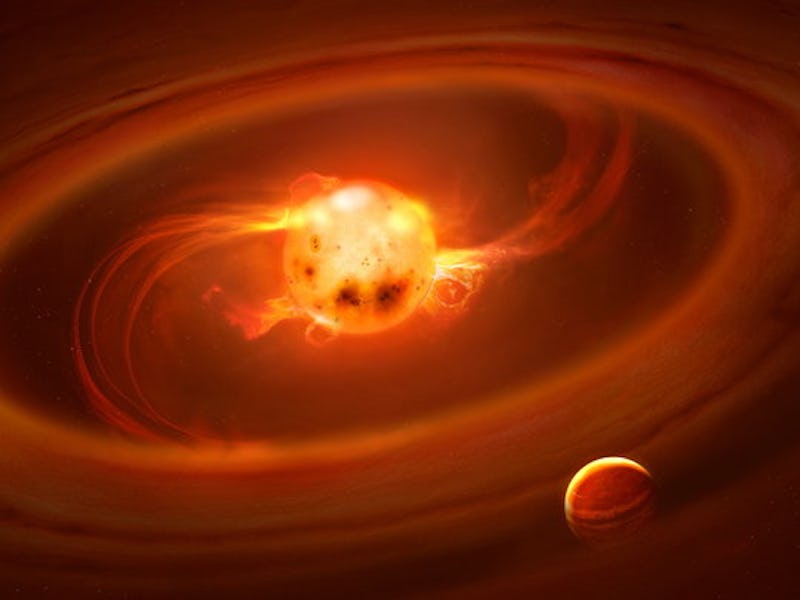New study shows how baby stars feed to grow up big and strong
New observations confirm a long-held theory about the birth of these cosmic beings.

Throughout the cosmos, massive clouds of molecular gas and dust experience extreme turbulence, causing them to collapse under their own gravitational force. In the collapse, the material at the clouds' center heats up, and turns hydrogen into helium. These hot, swirling centers eventually give birth to one of the universe's greatest beings: a star.
Before they reach their final mass, these baby stars are surrounded by the remains of the cloud from which they were born. The gas and dust form a disk around the star, which the stellar infant uses to grow in size.
But how exactly does the star feed upon this gas and dust? A team of astronomers at the European Southern Observatory (ESO) observed the vicinity of young stars to find out exactly how these gigantic babies feed.
Their findings are detailed in a study published Wednesday in the journal Nature.
An artist's impression of the disk of gas and dust surrounding a baby star.
It takes young stellar beings hundreds of thousands of years to grow into their final mass, as they draw from the surrounding gas and dust that has accumulated into a disk around them.
Some scientists believed that stars' gravitational force draws the material onto their surface, allowing them to feed off of it. But it turns out that is not the case. Due to the conservation of angular momentum, material such as gas and dust tends to orbit around a star by way of its gravitational force, rather than be drawn to its surface.
So how does the material drop directly onto a star's surface, allowing it to grow?
Using the European Space Organisation's high-resolution instrument GRAVITY, which combines four 8-meter telescopes in Chile into a virtual telescope, the researchers behind the new study observed the inner part of the gas disk surrounding a young star in the constellation Hydra, TW Hydrae.
"This star is special because it is very close to Earth at only 196 light years away, and the disk of matter surrounding the star is directly facing us," Rebeca García López, a researcher at the Max Planck Institute for Astronomy, Dublin Institute for Advanced Studies and University College Dublin, and lead author of the study, said in a statement.
"This makes it an ideal candidate to probe how matter from a planet forming disk is channeled on to the stellar surface."
The observations show that radiation emitted by the star system originates in the innermost region of the disk, where hydrogen gas falls onto the star's surface. This suggests the matter falling onto the star is being guided by the star's magnetic field through a process known as magnetospheric accretion.
The magnetic field of the star steers the gas from the inner rim of the disk to the surface of the star in a column-like flow. This enables the material to overcome the angular momentum enforced by the star's gravitational pull in such a way that the gas flows onto the star's surface, according to the study.
Similar to Earth's own magnetic field, gas from the inner rim of the disk that surrounds the star would be funneled to the North and South poles of the star.
The team of astronomers behind the new study are hoping to conduct further observations to get a more detailed idea of how the physical process works, and to better understand the star's magnetic field.
Abstract: Stars form by accreting material from their surrounding disks. There is a consensus that matter flowing through the disk is channelled onto the stellar surface by the stellar magnetic field. This is thought to be strong enough to truncate the disk close to the corotation radius, at which the disk rotates at the same rate as the star. Spectro-interferometric studies in young stellar objects show that hydrogen emission (a well known tracer of accretion activity) mostly comes from a region a few milliarcseconds across, usually located within the dust sublimation radius1,2,3. The origin of the hydrogen emission could be the stellar magnetosphere, a rotating wind or a disk. In the case of intermediate-mass Herbig AeBe stars, the fact that Brackett γ (Brγ) emission is spatially resolved rules out the possibility that most of the emission comes from the magnetosphere4,5,6 because the weak magnetic fields (some tenths of a gauss) detected in these sources7,8 result in very compact magnetospheres. In the case of T Tauri sources, their larger magnetospheres should make them easier to resolve. The small angular size of the magnetosphere (a few tenths of a milliarcsecond), however, along with the presence of winds9,10 make the interpretation of the observations challenging. Here we report optical long-baseline interferometric observations that spatially resolve the inner disk of the T Tauri star TW Hydrae. We find that the near-infrared hydrogen emission comes from a region approximately 3.5 stellar radii across. This region is within the continuum dusty disk emitting region (7 stellar radii across) and also within the corotation radius, which is twice as big. This indicates that the hydrogen emission originates in the accretion columns (funnel flows of matter accreting onto the star), as expected in magnetospheric accretion models, rather than in a wind emitted at much larger distance (more than one astronomical unit).